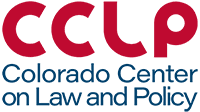Charles Brennan provided testimony in support of House Bill 24-1129, Protections for Delivery Network Company Drivers. CCLP is in support of HB24-1129.
Recent articles
CCLP testifies in support of TANF grant rule change
CCLP's Emeritus Advisor, Chaer Robert, provided written testimony in support of the CDHS rule on the COLA increase for TANF recipients. If the rule is adopted, the cost of living increase would go into effect on July 1, 2024.
CCLP testifies in support of updating protections for mobile home park residents
Charles Brennan provided testimony in support of House Bill 24-1294, Mobile Homes in Mobile Home Parks. CCLP is in support of HB24-1294.
CCLP’s legislative watch for April 5, 2024
For the 2024 legislative session, CCLP is keeping its eye on bills focused on expanding access to justice, removing administrative burden, preserving affordable communities, advocating for progressive tax and wage policies, and reducing health care costs.
Proposed rule could lock Coloradans out of coverage

Health care is, indeed, complicated. On top of the changes to the ACA now brewing at the House of Representatives, a lengthy proposed federal rule would create a whole host of obstacles to enrollment, beginning later this year. Provisions of the rule may look like mere technicalities, but could decimate enrollment unless people speak up. We’ve explained the basics below:
Proposed Health and Human Services rules released in early February and open to public comment just through March 7 have the stated goal of market stabilization, and may even help insurers’ bottom lines. However, they are likely to result in lower enrollment, higher out-of-pocket costs for consumers, smaller premium tax credits, and significant burdens on state systems. Affordability will worsen, particularly in the rural parts of the state where premiums are highest.
Some key provisions in the 70-page rule:
- The proposed shortened open enrollment period would run from Nov. 1 to Dec.15, 2017 for the 2018 plan year. This will require moving 180,000 people through the enrollment process in half the time typically provided.
- Connect for Health uses the Medicaid system’s Colorado Benefit Management System (CBMS) to determine applicants’ eligibility for federal assistance, so an overloaded system would affect not just those seeking premium tax credits, but also Health First Colorado and CHP+ enrollees. The result could be widespread delays, customer service problems, and higher IT costs.
- The shorter window may result in lower enrollment by younger and healthier Coloradans, since that group often enrolls late, while those with greater health needs typically enroll earlier.
- The actuarial value (AV) of metal-level plans will be able to dip lower, meaning that a 2018 plan would be termed “silver” but provide less coverage than a 2017 silver plan. The same goes for gold and bronze plans. That means that deductibles and cost-sharing will rise. Customers should expect higher out-of-pocket costs, with some estimating that silver-plan households could pay an additional $1,000 per year.
- If a lower AV range is approved and silver plans accordingly become skimpier, the amount of advance premium tax assistance (APTC) could be reduced.
- The rule could require that customers provide additional documentation if they enroll through a Special Enrollment Period (SEP). Colorado may not be required to make this change immediately, if state exchanges are given leeway to implement this aspect of the rule.
- Other provisions might require that applicants demonstrate continuity of coverage in order to enroll in a SEP, or to get coverage for pre-existing conditions, and would allow applicants to be rejected if they failed to pay premiums in the past. Because billing errors are common, this provision could be an obstacle for many applicants.
- Life-change events that allow SEPs – like marriage, the birth of a child, a move – are common for younger Coloradans. If obstacles to enrollment deter those healthier people, risk pools will worsen and premium costs will rise.
- Regulation of networks, meaning the providers and facilities included in a plan, could be weakened in many states. Colorado is likely to be able to retain authority over network adequacy requirements, thanks to the extensive work done by the state’s Division of Insurance in 2016 to set standards around provider networks.
- And though the rules, if finalized, may very well result in additional costs to Colorado, it appears that no federal money will be provided to assist with the changes.
Rarely do regulations impose such an abbreviated timeline for comment and implementation. If finalized, the additional time given to carriers to design and submit plans will result in curtailed schedules for our Division of Insurance and state exchange, with less time allowed for evaluating, adjusting, and loading plans on to the exchange system. These are time-intensive, technical tasks, and not easily rushed.
Measures like these don’t make the ACA work more smoothly. Instead, they undermine it, by creating barriers to enrollment. Coupled with the existing order that will minimize enforcement of the individual mandate, these rules, if finalized, will result in a shrinking risk pool that includes fewer healthy people. That means higher prices for those who want to retain coverage.
The ACA has provided Colorado with access to health care for all but 6 percent of residents. Let’s keep them covered and reject these new regulations.
– Bethany Pray





